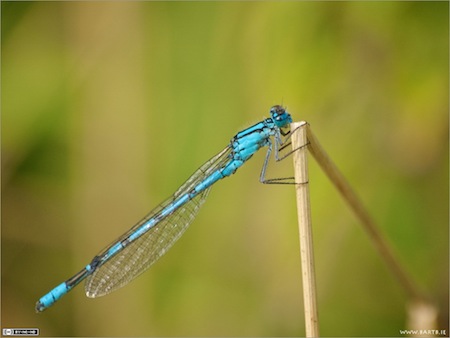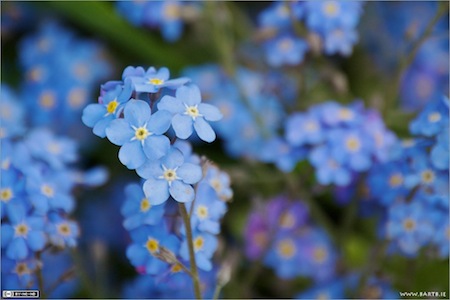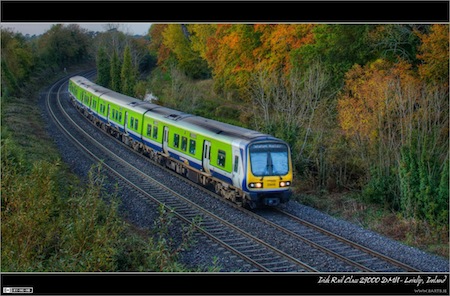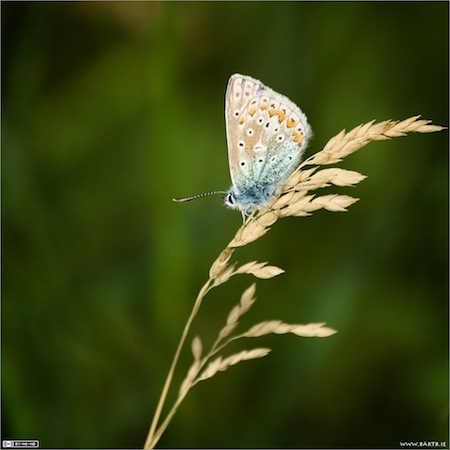Nov
24
Photo of the Week 145 – The Common Blue Damselfly
Filed Under Photography on November 24, 2010 | Leave a Comment
Last summer I mostly concentrated on wild flowers and Butterflies, this summer, I concentrated on Butterflies, Dragonflies and Damselflies. I’ve already shared a lot of my Butterfly shots in this series, and a Dragonfly one earlier in the year, so now I thought I’d share one of my favourite Damselfly shots from this summer.
This little guy is a male Common Blue Damselfly (Enallagma cyathigerum). As their name suggests this species are very blue, and not very rare, at least not along the banks of the Royal Canal. There is a complication though, there are three common species of blue damselfly along the canal, and they can look very similar to each other indeed! The key to telling them apart is the exact details of their markings. This angle doesn’t show it very well, but the Common Blue has a club-shaped black mark on the first segment after the wings. If you look carefully you can just about see it in this shot. If that club-shaped marking were to be u-shaped instead, then this would be an Azure Damselfly (Coenagrion puella).
These guys are smalL shy, and very fast, which makes them quite challenging to photograph. I don’t have a traditional macro lens anyway, but if I did, I don’t think I’d use it for Damselfly shots anyway. All my Damselfly (and most of my Butterfly) shots are taken with my trusty 55-200mm zoom, usually at full stretch at 200mm. Using a zoom rather than a macro lets me get closeup shots from a little further away, though it does come at a price. Zoom lenses compress distance, and the closer you are to your subject, the more pronounced this effect is. This results in a very shallow depth of field, so you need to stop down quite a bit before you get enough depth to get meaningful shots. Zooming in also magnifies any little shake in your hand, so as well as using a small aperture to get the DOF, you also have to use a fast shutter speed to get sharp focus. Both a small aperture and a fast shutter cut down the light a lot, so you really need a lot of light to get the shot – so, you generally need to shoot on sunny afternoons. This is not that big of a problem though, because Damselflies like the sun too! With a lot of patience and perseverance, and perhaps a little luck, you can get some nice shots of these wonderful insects without the need for fancy expensive kit.
As I tried more and more damselfly shots over the summer, I soon got plenty of sharp ones, but the problem was getting a good background. These little fellas like to hide between long grass, so you tend to get grass poking into the frame all over the place, causing a lot of clutter in the background, and often even sticking in front of parts of the insect’s body, wings or tail. My perseverance paid off though, and later in the summer I got lucky when this guy posed for me on the tallest blade of grass along a bank – he was close to eye-level, and was happy to sit there while I got close enough to get this shot. Because he was on the tallest blade of grass, there was no clutter to get in the way, and I was able to angle the camera to get the nearest background object to be far enough away to be fully out of focus, giving this nice uncluttered shot
- Camera: Nikon D40
- Lens: Nikon DX AFS 55-200mm
- Exposure: 1/400 sec
- Focal Length: 200mm
- Focal Ratio: f/8
- ISO: 400
- Camera Mode: Aperture Priority
Nov
15
Photo of the Week 144 – Forget-me-not
Filed Under Photography on November 15, 2010 | Leave a Comment
It’s been a while since I’ve chosen a flower photo for Photo of the Week, so I decided to remedy that this week. This is a shot of one of my favourite little flowers, they have a fantastic pale blue colour, and wonderfully fine details in their tiny flowers. It can be quite hard to tell the different varieties of Forget-me-not apart, but I think this is Field Forget-me-not (Myosotis arvensis).
- Camera: Nikon D40
- Lens: Nikon DX AFS 55-200mm
- Exposure: 1/640 sec
- Focal Length: 200mm
- Focal Ratio: f/5.6
- ISO: 400
- Camera Mode: Aperture Priority
Nov
11
Photo of the Week 143 – Autumn Boat Train
Filed Under Photography on November 11, 2010 | 1 Comment
With this long-drawn out illness the past few months I’ve literally missed all the Autumn colour this year. So, since I got no new autumnal pictures this year, I thought I’d share of of my favourites from last year.
Here we see an evening train service from Maynooth to the port in Rosslare as it rounds the fairly sharp turn on the approach to the new Matt Goff Bridge just in Leixlip. This shot has been quite heavily tonemapped to bring out the best of the colours, I have a feeling some people may find the processing a little too extreme, but I like it, and since it’s my photo that’s all that matters 😉
For the train spotters among you, this is an Irish Rail Class 29000 railcar set, number 29018 to be precise. If you have good eyesight you can probably read the number on the front of the train which reads 29418, it will read 29118 on the other side, and the middle two carriages will have the numbers 29218 and 29318, hence the whole unit is referred to as 29018. These units come in blocks of 4, but can be joined together to make larger trains of 8 or even 12 carriages. The 29000s are very much the work horses for Irish Rail’s commuter and local services, though you do sometimes see them on longer national routes too. From a passenger comfort point of view, they’re fine for short services, but I’m not along in groaning when I see one pull up to the platform when I’m travelling InterCity.
- Camera: Nikon D40
- Lens: Nikon DX AFS 18-55mm (D40 kit lens)
- Exposure: 1/200 sec
- Focal Length: 30mm
- Focal Ratio: f/3.5
- ISO: 200
- Camera Mode: Full Manual
- Processing: created by tonemapping a single RAW image with Photomatix Pro, and then tweaking the resulting image with Aperture’s built-in Dodge & Burn plugin
Nov
8
Longest Words Followup – Java -v- Perl
Filed Under Computers & Tech, 42 (Life the Universe & Everything) on November 8, 2010 | Leave a Comment
Yesterday I posted about using Perl to solve the question “what’s the longest word I can type with just half a keyboard?”. My self an Connor were joking that it would be a lot more difficult with Java, first to write the code, then to run.
I literally used the identical algorithm for the Java program, even using the same variable names, and printed the results out identically (I verified this with the Unix diff command). I also did my best to use the various built-in Java functionality and java.util classes to minimise the amount of heavy lifting my code had to do.
Nov
8
Longest Word With Just Half a Keyboard?
Filed Under Computers & Tech, 42 (Life the Universe & Everything) on | 2 Comments
As some of you may know, I’ve been ill for the past few weeks now, and hence not working or podcasting. I spend a lot of my time doing nothing because I have no energy and often a headache, but when my head is clear I have a lot of thinking time since doing physical things is not possible. I even need to be careful not to type too much or my arms get very sore!
Anyhow – yesterday Bren Finan was chatting with me when he noticed that ‘yesterday’ uses only keys from one half of the keyboard. Which got him, and hence me, wondering if there was a longer word that can be written with just half a keyboard. (The quick-witted among you will probably spot that ‘Yesterday’ doesn’t actually count because the ‘y’ is on the wrong side of the divide on ergonomic keyboards.)
Nov
1
Photo of the Week 142 – The Common Blue
Filed Under Photography on November 1, 2010 | 1 Comment
One of my favourite muses this year has been the Common Blue butterfly (Polyommatus icarus). It’s just so beautiful, and this was a good year for them in Ireland. The summer’s long gone now, but it comes back to me vividly when I look at this shot.
This is definitely one of my favourite shots of the Common Blue from this year. In many ways this is very clichéd shot, these guys love sitting on grass seed stalks, so you see loads of shots of them in this pose. However, this ones stands out to me because of the wonderful soft evening light, and the strong contrast between the butterfly and the background. This was possible because this guy was friendly enough to sit on a grass stalk that was in sunlight, while the background behind it was in shade.
- Camera: Nikon D40
- Lens: Nikon DX AFS 55-200mm
- Exposure: 1/400 sec
- Focal Length: 200mm
- Focal Ratio: f/8
- ISO: 400
- Camera Mode: Aperture Priority
- Exposure Bias: -0.7ev










